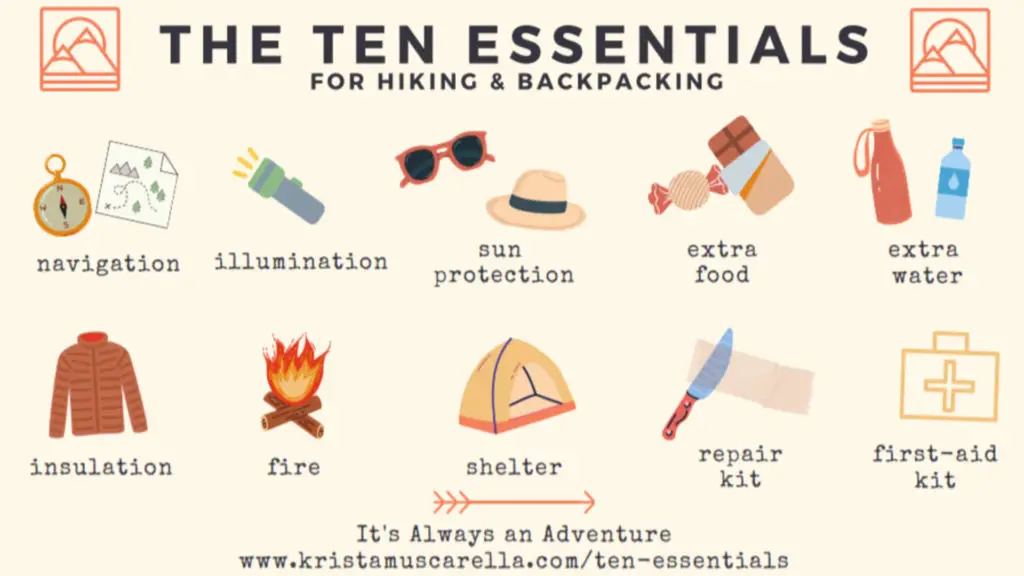There are ten items you should bring with you on any hike no matter how how calm the weather is when you start out, how short you think your hike is going to be, what great shape you’re in, or how close to civilization the trail begins, because emergencies do happen. The original Ten Essentials list was assembled in the 1930s by The Mountaineers, a Seattle-based organization for hikers and climbers, to help people be prepared for nearly any unexpected situation in the outdoors:
- Navigation: map, compass, altimeter, GPS device, personal locator beacon (PLB) or satellite messenger
- Headlamp: plus extra batteries
- Sun protection: sunglasses, sun-protective clothes, and sunscreen
- First aid kit: including foot and wound care
- Knife: plus a gear repair kit
- Fire: matches, lighter, tinder and/or stove
- Shelter: carried at all times (can be a light emergency bivy)
- Extra food: Beyond the minimum expectation
- Extra water: Beyond the minimum expectation
- Extra clothes: Beyond the minimum expectation
- Navigation: Only bring a compass and map if you know how to use them. This may sound silly but with the advent of GPS and so many navigation apps for phones, there is a whole new generation of people who don’t know how to use these tools. But keep in mind that nature is notorious for not having a cell signal, and relying on apps only works if your phone doesn’t run out of battery (portable charger? Solar charger?). Satellite communication devices like the Garmin In-reach are becoming more popular and have saved many lives.
- Headlamp: I love my Petzl ActikCore for its battery options (standard or rechargeable) and high lumens (250) but you can find some good reliable ones at hardware and sporting goods stores as well. Even if you aren’t planning on being out late, it’s amazing how dark the forest gets and how much earlier than the actual sunset time. Being caught off-guard by the night can be a frightening experience, and depending on weather and location could mean the difference between life and death.
- Sun protection: For your eyes and skin, and don’t forget lips. Badger makes a couple of great sunscreens, and Bight’s sun hoodie is a perfect lightweight layer to stay covered while staying cool. Depending on your terrain, you may find anything from regular sunglasses to performance ski goggles to be the best choice for eye protection. Julbo’s glacier goggles are a great in-between, providing full side coverage and UV lenses.
- First Aid: There are some great pre-assembled first aid kits on the market, or you can build your own. What you bring depends a lot on your particular needs, but at the very least, have something like the following: band aids, antiseptic wipes, tweezers, antibiotic cream, duct tape, ibuprofen, Benadryl, moleskin or other blister care, and a small pair of scissors. Over time you might add things like hand warmers, insect bite spray, medicine for stomach issues, or a small ace bandage. Bug spray is a good addition too.
- Knife: A good knife or a multitool can plus a gear repair kit can help with a myriad of issues, from self-defense to food prep and gear emergencies. Leatherman and Gerber both make some outstanding knives and multitools.
- Fire: Bring matches, lighter, tinder, and/or stove. For staying warm, for melting snow or sanitizing water, for a rescue signal, for cooking. JetBoil’s tiny stove packs quite the punch and for the weight (14 oz, 4 for fuel) you can’t afford not to throw one in your pack
- Shelter: Carry some form of emergency shelter with you at all times; if you aren’t camping, something like the SOL Emergency Bivvy or similar greatly increases your odds of surviving an unexpected night out in the wilderness.
- Extra food: Beyond the minimum expectation
- Extra water: Beyond the minimum expectation
- Extra clothes: Depending on where you’re hiking, day and night can easily have a fifty temperature difference. On a Mt. Whitney hike, I went from 86 degrees at 1 am when I started, to a chilly 30-something on the shady windy backside at 13,000 feet, to a pleasant 50s at the summit with no breeze, and then back into a hot dry 90s when I finished in the later afternoon. It was 102 in town that day, yet summit parkas were in full bloom. This is not unusual, nor are tank top days with below freezing nights. Throw any rain, snow, water crossings gone awry, or sweat-soaked base layers, etc into the equation and you’re going to wish you had that extra fleece or those wool leggings that usually just stay in the bottom of your pack. I bring extra socks even on short day hikes, and gloves from October to July. The weight of extra clothes and the space they take up is nothing compared to the benefit they offer.
You may find yourself adjusting and adding to this list and creating your own 11th and 12th essentials, such as self-defense or an extra roll of film or an insulted pad to sit on. But those ten are the tried and true classics that have helped generations of hikers through what could have been some bad nights or fatal incidents.

Wendy Harrington is a California native who has lived in a small town at the foothills of the Cascade Mountains in Washington state since 2001. Her love of trail running and peakbagging has led her to summit all five Washington volcanoes, climb to the high points of three states, and put nearly a thousand miles a year on her boots. Her loves include ridgelines, saddles, granite, one-day pushes on big mountains, anything volcanic, long solo days, and objectives that push limits and test endurance.

